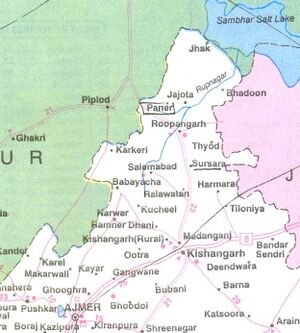Kishangarh: Difference between revisions
No edit summary |
|||
| Line 176: | Line 176: | ||
*[[Chundiwal]], | *[[Chundiwal]], | ||
*[[Gandhas]], | *[[Gandhas]], | ||
*[[Mundwadiya]], | |||
*[[Sewda]], | |||
*[[Sewdiya]], | |||
== Notable persons == | == Notable persons == | ||
*[[Jagdip Dhankar]] - MLA from Kishangarh | *[[Jagdip Dhankar]] - MLA from Kishangarh | ||
Revision as of 08:21, 23 September 2010

Kishangarh (किशनगढ़) is a city and a municipality in Ajmer district in Rajasthan. It lies 18 miles north-west of Ajmer. It is well connected via Indian Railways and National Highway #8. It is the birth place of the Kishangarh style of painting. In recent years, Kishangarh has come to be known as the marble city of India. It is purported to be the only place in the world with a temple of nine planets
Villages in Kishangarh tahsil
Aau, Almas, Amarpura, Ankauriya, Arain, Bakarwaliya, Balapura, Balapura, Bandar Seendri, Bansra, Bansra (Mehran), Bargaon, Barna, Beenjarwara, Beeti, Bhadoon, Bhambholao, Bharla, Bhawsa, Bhilawat, Bhogadeet, Bhojiyawas, Bhunwada, Brijpura, Buharoo, Chak Beer, Chak Peenglod, Cheeta Khera, Choondari, Chosla, Churli, Dadiya, Dang, Dardoond, Deendwara, Deopuri, Dhani Deomand, Dhani Purohitan, Dhani Purohitan, Dhani Rathoran, Dhasook, Dholpuriya, Dothli, Gagoonda, Gahalpur, Ganeshpura, Ghaswan Ki Dhani, Godiyana, Goli, Goojarwara, Goondli, Gopalpura, Gordhanpura, Gothiyana, Gudli, Gurha, Harmara, Indoli, Jajota, Jakholai, Jhadol, Jhag, Jheerota, Joonda, Jorawarpura, Jugalipura, Kachariya, Kadha, Kakalwara, Kakniyawas, Kalanada, Kali Doongri, Kalyanipura, Kalyanpura, Kalyanpura, Kardala, Karkeri, Kathoda, Katsoora, Kebaniya, Keriya, Keriya Ki Dhani, Khajpura Bhairwai, Khandach, Khatoli, Khera, Khera Karmsotan, Kishangarh (M), Kishanpura, Kishnpura, Kotri, Kucheel, Lamba, Mala, Mandawariya, Mandawariya, Mandiyawad Kalan, Mandiyawad Khurd, Manpura, Mohan Pura, Mokhampura, Moondolao, Moondoti, Mordi, Mothi, Motipura, Motipura, Mundoti, Naloo, Narena, Nawa, Naya Gaon, Nitooti, Nohariya, Nonandpura, Nonandpura, Nosal, Pacheenpala, Padanga, Palri Bhoptan, Palri Pathanan, Pandarwara, Paner, Parasoli, Patan, Pawaron Ki Dhani, Pedi Bhata, Peenglod, Phaloda, Raghunath Pura, Raghunathpura, Raheempura, Rajpura, Ralawatan, Ramgarh, Rampura, Rari, Rodawas, Roopangarh, Sagarmala, Salemabad, Sandoliya, Sar Gaon, Sarwar, Seel, Seengla, Silora, Singara, Sinodiya, Sinroj, Sursura, Thal, Tihari, Tikawara, Tiloniya, Tityari, Tokra, Tolamal, Tyod, Udaipur Kalan, Udaipur Khurd, Ujoli,
Kishangarh inscription
Kishangarh inscription in Devanagari script at village Nirana provides evidence of the rule of the Jewlia clan of Jats prior to the 10th century in Rajasthan. A Jewlia Jat chieftain had a chhatri constructed at Kishangarh. To the southwest of this chhatri is a victory pillar and a statue of a Jat chieftain of the Jewlia gotra, with an inscription of samvat 1111 (1054 AD). To the north of this chhatri, at a distance of 15 feet, there is an ancient masonry tank used to provide drinking water for cows, and a well, constructed from skilfully dressed and cut stones, demonstrating a high degree of talent in architecture. To the west of this chhatri is a huge pond spread over 50 bigha of land, also constructed by Jewlia Jat chieftains.
A gold coin was obtained in excavation near the above chhatri, engraved on one side with an image of the king with bow and arrow, and on the other side there with images of agni-kunda. The coin provides evidence for an ancestor of the present Jewlia clan being a king in the period prior to the 10th century.
Jat Gotras
Notable persons
- Jagdip Dhankar - MLA from Kishangarh
Reference
- Thakur Deshraj: Jat Itihas (Hindi), Maharaja Suraj Mal Smarak Shiksha Sansthan, Delhi, 1934, 2nd edition (1992), pages 725-729.
Back to

